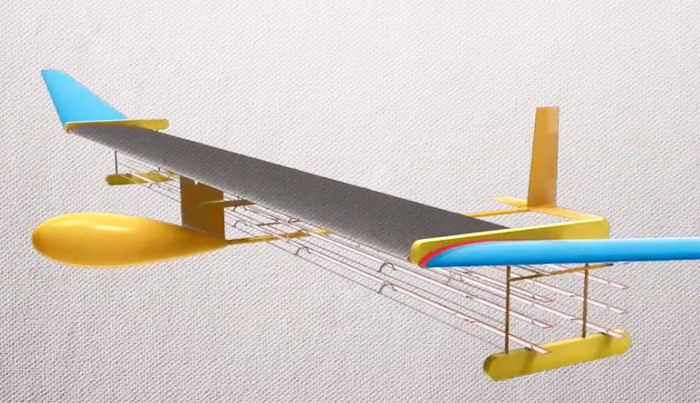Ion propulsion powers model aircraft
December 03, 2018
on
on

In science fiction Ion power is a favorite propulsion method for space vehicles, in reality this technology is now not so futuristic since it has been successfully deployed to power space probes such as Deep Space 1 and is also routinely used in the form of thrusters to correct the position of satellites in orbit.
Now Steven Barret together with researchers at MIT has achieved a first: they managed to propel a heavier-than-air craft using an ion engine operating in Earth’s atmosphere rather than the vacuum of space.
Video of the craft's first flight featuring Steven Barret from MIT.
The principle of the ion engine used in this model could hardly be simpler: Beneath the model is an array of thin wires set horizontally under each wing carrying a DC charge of +20,000 V. An array of small aerofoil sections parallel and downwind of the wires carry a charge of -20,000 V. The positively charged wire produces a cloud of nitrogen ions from gas in the atmosphere which are then attracted to the negatively charged aerofoil. As the ions travel rearwards they collide with static neutral air molecules creating an ‘ionic wind’ which imparts a net forward thrust to the aircraft.
When operating in the vacuum of space it’s necessary to carry a source of gas to be ionised and propelled out the rear of the spacecraft. The particles have relatively low mass but are ejected at very high speed, the fuel payload is therefore much lower than a conventional rocket motor which relies on chemical reaction to provide thrust. This makes ion propulsion an attractive technology for prolonged space travel.
In the Earth’s atmosphere it’s not necessary to carry any gas because the air itself is used as the ‘fuel’. The voltage levels used by the ion engine are very high, at high altitude above major weather systems atmospheric humidity is very low but closer to the ground variable weather conditions may make it tricky to maintain the necessary level of electrical isolation.
The technology is in its infancy and there are still lots of hurdles to overcome before a practical craft is wheeled out of its hangar. As you can see in the video, the level of thrust produced by the engine is barely sufficient to maintain level flight of the lightweight model. It is still a remarkable achievement to produce silent, powered flight without any obvious means of mechanical propulsion.
Now Steven Barret together with researchers at MIT has achieved a first: they managed to propel a heavier-than-air craft using an ion engine operating in Earth’s atmosphere rather than the vacuum of space.
The principle of the ion engine used in this model could hardly be simpler: Beneath the model is an array of thin wires set horizontally under each wing carrying a DC charge of +20,000 V. An array of small aerofoil sections parallel and downwind of the wires carry a charge of -20,000 V. The positively charged wire produces a cloud of nitrogen ions from gas in the atmosphere which are then attracted to the negatively charged aerofoil. As the ions travel rearwards they collide with static neutral air molecules creating an ‘ionic wind’ which imparts a net forward thrust to the aircraft.
When operating in the vacuum of space it’s necessary to carry a source of gas to be ionised and propelled out the rear of the spacecraft. The particles have relatively low mass but are ejected at very high speed, the fuel payload is therefore much lower than a conventional rocket motor which relies on chemical reaction to provide thrust. This makes ion propulsion an attractive technology for prolonged space travel.
In the Earth’s atmosphere it’s not necessary to carry any gas because the air itself is used as the ‘fuel’. The voltage levels used by the ion engine are very high, at high altitude above major weather systems atmospheric humidity is very low but closer to the ground variable weather conditions may make it tricky to maintain the necessary level of electrical isolation.
The technology is in its infancy and there are still lots of hurdles to overcome before a practical craft is wheeled out of its hangar. As you can see in the video, the level of thrust produced by the engine is barely sufficient to maintain level flight of the lightweight model. It is still a remarkable achievement to produce silent, powered flight without any obvious means of mechanical propulsion.
Read full article
Hide full article



Discussion (4 comments)
cjhellin 6 years ago
http://jnaudin.free.fr/lifters/main.htm
Don Stratton 6 years ago
Murray Dickinson 6 years ago
Ethan Krauss 6 years ago
While it is true that in the MIT paper and video, it is stated that their device is the "first ion propelled aircraft of any kind to carry its power supply." Clearly, the statement is historically incorrect.
Please google "Self Contained Ion Powered Aircraft", if you would like to see videos, website, and other info on the subject.